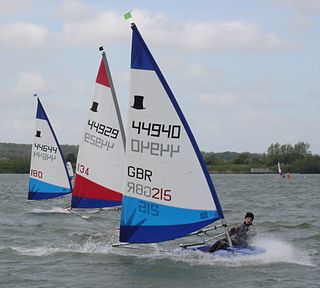Related Research Articles
Beaufort may refer to:

Dinghy sailing is the activity of sailing small boats by using five essential controls:
The Mirror is a popular sailing dinghy with more than 70,000 built.

The Topper is an 11 foot 43 kg (95 lb) sailing dinghy designed by Ian Proctor. The Topper is a one-design boat sailed mostly around the British Isles. It was recognised as a World Sailing Class. The boat is constructed from polypropylene, and is popular as a racing boat or for sail training. The class association (itca) organise racing events, which range from small travellers to major championships. The RYA run squads alongside the events; in these squads are talented young sailors who are given specialist race coaching.

The GP14 is a popular sailing dinghy, with well over 14,000 built.

The National 12 is a two-person, two-sail, twelve-foot long sailing dinghy. They are sailed extensively in the UK. The class was started in 1936 by the Royal Yachting Association as an alternative to the more expensive International 14s.

The Wayfarer is a wooden or fibreglass hulled fractional Bermuda rigged sailing dinghy of great versatility; used for short 'day boat' trips, longer cruises and for racing. Over 11,000 have been produced as of 2016.
Jack Holt, OBE (1912–1995) was a prolific designer of sailing dinghies. His pioneering designs of dinghies using plywood did much to popularise the sport of sailing in the period immediately following World War II.

A Bermuda rig, Bermudian rig, or Marconi rig is a configuration of mast and rigging for a type of sailboat and is the typical configuration for most modern sailboats. This configuration was developed in Bermuda in the 17th century; the term Marconi, a reference to the inventor of the radio, Guglielmo Marconi, became associated with this configuration in the early 20th century because the wires that stabilize the mast of a Bermuda rig reminded observers of the wires on early radio masts.

The Wanderer is a 14-foot Fibreglass hull Bermuda rigged sailing dinghy designed by Ian Proctor. One of the main objectives of the design was to produce a robust safe and versatile dinghy that could be used for knockabout day sailing and cruising as well as racing, but was light enough to be handled ashore.

The Adventuress sailing dinghy class was designed by Ian Proctor and built by Anglo Marine of Essex. It is no longer in production.
The Bell Woodworking Seagull and Seamew are both small sloop-rigged marine ply sailing boats of the Trailer yacht type designed by Ian Proctor, who was also responsible for the design of many small sailing dinghies in seven different classes including the extremely popular Topper, and Wanderer.
Ian Douglas Ben Proctor, known as Ian Proctor, was a British designer of boats, both sailing dinghies and cruisers. He had more than one hundred designs to his credit, from which an estimate of at least 65,000 boats were built. His pioneering aluminium mast designs also revolutionised the sport of sailing.
Phil Morrison is a British boat designer and racer rendered notable by the success of his many designs in many classes since 1967 as well as his own distinguished yacht racing career.

The CL 16 is a Canadian-designed 16' sloop sailboat, designed by Henry Croce and Ken Lofthouse in 1967-68 in Mahone Bay, NS. It is essentially the same design as the Wayfarer dinghy, with the addition of a double-hull and a more comfortable cockpit for recreational users. It was produced in Mahone Bay until 1968 when production was moved to the Toronto area. It continued to be produced by a Canadian company in Fort Erie, on Lake Erie, which began production in 1993 after being produced by David Waterhouse, Anne Waterhouse and Bob May in Pickering ON from 1969 to 1989. Now in 2018, CL BoatWorks was purchased by Velocity BoatWorks and all CL production has been moved to Belleville, Ontario on the Bay of Quinte.
The Bosun is a 14-foot GRP sailing dinghy originally created for the Royal Navy by designer Ian Proctor and built by Bossoms Boatyard in 1963. The design specification was for a robust dinghy, able to handle open seas, capable of carrying a crew of 3 to 4 people and be fast enough for a competent helm to enjoy sailing, whilst stable enough for a beginner to learn on.
The Marlin is a 14-foot 2/3 person sailing dinghy designed and built by Ian Proctor.
The Mirror 16 is a class of sailing dinghy which was sponsored by the Daily Mirror newspaper in 1963 and the design project was headed by Jack Holt. Its design was based upon the easy to construct stitch and glue principle introduced by Barry Bucknell for the Mirror 11 dinghy. The Mirror 16 was designed for the racing enthusiast and also the camping/potterer dinghy sailor. The concept was a relatively light dinghy with a large sail area that could easily be reefed. The main sail was designed for slab reefing and the large genoa had roller reefing. The Mirror 16, like the Mirror 11, was produced with distinctive red sails. The Mirror 16 was faster than the Proctor-designed Wayfarer.

The Gull sailing dinghy was designed by Ian Proctor in 1956, originally as a frameless double-chine plywood boat. However, it has been through several incarnations: the wooden Mark I, GRP Mark III, GRP Gull Spirit and GRP Gull Calypso. Today it is popular with sailing schools, especially in the UK.

The Minisail is a 13-foot single-handed dinghy which was designed by Ian Proctor in 1959 and became popular in the 1960s. It was the predecessor to the Topper and was the first British production boat to popularise the idea of the "sailing surfboard". As the Topper gained popularity in the 1980s, the Minisail disappeared from the scene. However, on 28 August 2011, a group of enthusiasts restarted the Minisail Class Association, which now has a small but committed following mainly in north-west Europe.
References
- ↑ "The West Country Cruise on the River Tamar - Sept 6/7th 2003". Archived from the original on 6 January 2009. Retrieved 2008-11-23.
Besides the Wanderer fleet, Janet and Anthony Byrde in their Drascombe and Richard and Peter Goodfellow, in another Ian Proctor designed dinghy called a Beaufort, were sharing the Cruise with us.
| This article about a type of ship or boat is a stub. You can help Wikipedia by expanding it. |